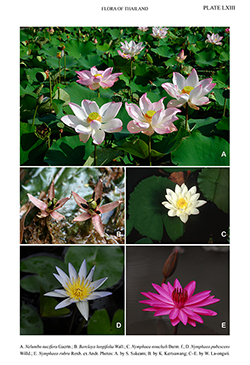e-Flora of Thailand
Volume 14 > Part 4 > Year 2020 > Page 548 > Nymphaeaceae > Nymphaea
2. Nymphaea pubescens Willd.wfo-0000382124
Sp. pl. 2(2): 1154. 1799; DC., Syst. Nat. 2: 52. 1821; Cornard in Carnegie Inst. Wash. Publ. 4: 198. pl. 17. 1905; Gamble, Fl. Pres. Madras 1: 34. 1915 (Repr.ed. 1: 24. 1957); Royen, Nova Guinea 8 ser.5: 107. f. 1. 1962; Backer & Balkh. f., Fl. Java 1: 148. 1963; Mitra in Nayar et al., Fasc. Fl. India 20: 18, 1990; in Shama et al., Fl. India 1: 431, 1993; Dassanayake, Revis. Handb. Fl. Ceylon 5: 290. 1996.— Nymphaea lotus var. pubescens (Willd.) Hook. & Thoms., Fl. Ind. 1: 241. 1855; in Hook.f., Fl. Brit. India 1: 114. 1875. Plate LXIII: D.
Accepted Name : This is currently accepted.
Synonyms & Citations :
Description : Leaves with terete, pubescent petioles; lamina ovate, elliptic or suborbicular, 15–40 by 12–35 cm; above glabrous; below pubescent, venation pattern less prominent, basal lobes acute or obtuse, margins irregularly dentate, apex round or obtuse. Flowers 4–15 cm in diam., distinctly fragrant, anthesis nocturnal. Sepals 4, ovate or lanceolate, 2–7 by 1.5–2.5 cm, abaxially green, sometimes with purplish tinge, 5 (–9) prominent veins, pubescent or glabrous, adaxially white, apex obtuse. Petals 12–20, outermost oblanceolate, next wholes lanceolate, innermost narrow-lanceolate, 2–7 by 1.2–2 cm, white, sometimes outermost with purplish tinge abaxially, apex obtuse or acute. Stamens 30–90, outermost 1.5–3.5 cm long, yellow, filaments laminar, yellow; anthers yellow. Ovary 13–20-locular, syncarpous; stigmatic appendages, ca 1 cm long, linear, with obtuse, yellow, incurved apex. Fruit 3–6 cm in diam., green, with filament remnants. Seeds elliptic-globose, 1–1.5 mm long., blackish brown, with longitudinal rows of papillae.
Thailand : NORTHERN: Chiang Mai, Lampang, Kamphaeng Phet, Nakhon Sawan (Bueng Borapet); NORTH-EASTERN: Nong Khai, Sakon Nakhon (Nong Han), Mukdahan (Phu Sa Dok Bua NP), Maha Sarakham, Khon Kaen; SOUTH-WESTERN: Uthai Thani, Phetchaburi (Cha Um), Phachuap Khiri Khan (Khao Sam Roi Yot NP); CENTRAL: Chai Nat, Krung Thep Maha Nakhon (Bangkok) (Bang Bon); SOUTH-EASTERN: Rayong (Klaeng); PENINSULAR: Phatthalung (Tha Le Noi WS), Songkhla (Tha Le Sap Songkhla Non Hunting Area), Satun (Thale Ban NP).
Distribution : Sri Lanka, India (type), Myanmar, Laos, Cambodia, Vietnam, Malaysia, the Philippines, Indonesia, New Guinea.
Ecology : Fresh or brackish waters of large swamps, lakes, and rice paddies, from near sea level to 500 m alt. Flowering and Fruiting: late June to middle of September.
Vernacular : Bua kin sai (บัวกินสาย), bua khom (บัวขม), bua khi phae (บัวขี้แพะ).
Uses: Young peduncles are consumed as vegetables.

